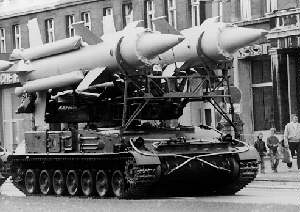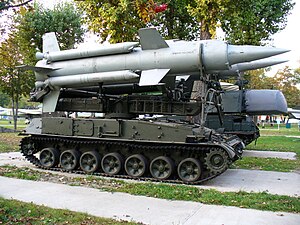| 2K11 Krug NATO reporting name: SA-4 "Ganef" | |
|---|---|
 2K11 TEL in transit | |
| Type | Transportable SAM system |
| Place of origin | Soviet Union |
| Service history | |
| In service | 1964–present |
| Used by | See list of operators |
| Production history | |
| Designer | Lyulev Novator |
| Designed | 1957 |
| Manufacturer | MZiK |
| Variants | Krug, Krug-A, Krug-M, Krug-M1, Krug-M2, Krug-M3 |
| Specifications (2K11 Krug[1]) | |
| Mass | 28,200 kg |
| Length | 7.5 m (9.46 m with missiles) |
| Width | 3.2 m |
| Height | 4.472 m (with missiles) |
| Crew | 3 to 5 |
|
| |
| Armour | 15 mm |
| Engine |
V-59 V-12 water-cooled diesel 520 hp |
| Power/weight | 17.33 hp/t |
| Ground clearance | 0.44 m |
| Fuel capacity | 850 litres |
Operational range | 780 km |
| Maximum speed | 35 km/h |
The 2K11 Krug (Russian: 2К11 «Круг»; English: circle) is a Soviet and now Russian long-range, medium-to-high altitude surface-to-air missile (SAM) system. "2K11" is its GRAU designation, while SA-4 Ganef is its NATO reporting name. The system was designed by NPO Novator and produced by Kalinin Machine Building Plant.
Development and service[]
Development of the Krug ZRK-SD (2K11) air defense system started in 1957 by the Lyulev OKB design bureau. It was first displayed during a parade in Moscow in May 1964. The system started to be fielded in 1967 and became fully operational in 1969. It was used by the Russian Army as a long-range SAM.
The early version of the Krug entered service in 1965. The first operational deployment version, the Krug-A, entered service in 1967, with extensively modified versions, the Krug-M in 1971 and the Krug-M1 in 1974, which were developed to rectify problems discovered during army service.[1] The upgraded version Krug-M was fielded in 1971 and the Krug-M1 in 1974. A target drone called 9M316M Virazh, developed from obsolete Krug missiles, was proposed for export in 1994.[2][3]
The 2K11 was briefly operated by the Soviet army during the war in Afghanistan in 1979 and 1980, but was withdrawn several months after the initial invasion.[4] In 1997, it was reported[2] that, between 1993 and 1996, some 27 fire units of Krug and 349 missiles had been sold to Armenia. Poland flight tested four missiles in September 2006 against P-15 Termit (SS-N-2 'Styx') targets.

The P-40 "Long Track" radar set.
Description[]
Vehicles[]
The TEL vehicles are tracked (modified AT-Ts) based on a GM-123 chassis and carry two missiles each on an elevating turntable for up to 360-degree rotation and 70-degree elevation. The two primary versions of the missile in service are the 9M8M1 (2K11M "Krug-M") and 9M8M2 (2K11M2/3 "Krug-M1"), both of which are believed to be known to the US DoD as SA-4B. The original 9M8M (SA-4A) was first introduced into service in 1965 and followed by the upgraded 9M8M1 (2K11A "Krug-A") in 1967 before the 9M8M1 in 1971 and the 9M8M2 in 1973. The 9M8M2 actually has a lower maximum engagement altitude and shorter range in exchange for better performance in engaging aircraft close to the battery. Each battery typically consists of two 9M8M1 missiles and four 9M8M2 missiles as well as the following radars:
- P-40 "Long Track" E-band early warning radar (also used by the SA-6 and SA-8, range 175 km/108 miles)
- "Pat Hand" H-band continuous wave fire control and guidance radar (range 128 km/80 miles)
- "Thin Skin" E-band height finding radar (also used by the SA-6 and SA-8, range 240 km/148 miles)
Both "Long Track" and "Pat Hand" are mounted on a modified AT-T vehicle, similar to the 9M8 launch vehicles. "Thin Skin" is mounted on a truck. Batteries may also feature Ural trucks carrying spare missiles for reloading the launchers.
Missile[]
| 9M8 | |
|---|---|
 TEL at Ukrainian Air Force Museum in Vinnitsa. | |
| Type | Surface-to-air missile |
| Place of origin | Soviet Union |
| Production history | |
| Variants | 3M8 (later 9M8) Krug, 9M8M Krug-M, 9M8M1 Krug-M1, 9M8M2 Krug-M2, 9M8M3 Krug-M3. |
| Specifications (9M331[1]) | |
| Mass | 2,453 kg |
| Length | 8.784 m |
| Diameter | 86 cm |
| Warhead | Frag-HE |
| Warhead weight | 150 kg |
Detonation mechanism | contact and proximity fuzes |
|
| |
| Propellant | kerosene fuelled ramjet |
Operational range | 55 kilometres (34 mi) |
| Flight altitude | 24,500 metres (80,400 ft) |
| Boost time | four solid fuel booster rocket motors |
| Maximum speed | 1100 m/s |
Guidance system | Radio command, semiactive radar |
The missiles are launched with the aid of four solid fuel rocket motors inside boosters attached to the outside of the massive missile. Once they have burned and the missile is aloft, it fires a liquid-fuelled ramjet sustainer engine. It reaches speeds of up to Mach 4 and has an effective range of 50–55 km (31–34 miles) depending upon the version. It carries a 135 kg (300 lb) warhead. Possible engagement altitudes range from 100 m-27 km (330-88,500 feet). 3M8 missile was designed and produced by NPO Novator.
Missile guidance is via radio command with a terminal semi-active radar homing (SARH) phase. Optical tracking is possible for the initial command guidance stage in a heavy ECM environment.
Structure of Krug missile system[]
- Self-propelled launch vehicle 2P24
- Rocket guidance station 1S32
- Target detection station 1S12
- Transporter-loader vehicle 2T6
Operators[]
Current operators[]
 Armenia 115[1]
Armenia 115[1] Azerbaijan[1]
Azerbaijan[1] Turkmenistan - 30[1]
Turkmenistan - 30[1] Kyrgyzstan[citation needed]
Kyrgyzstan[citation needed] North Korea - unknown number[citation needed]
North Korea - unknown number[citation needed]
Former operators[]
 Czechoslovakia had 1 brigade. Phased out in early 1990s.
Czechoslovakia had 1 brigade. Phased out in early 1990s. East Germany. Passed onto successor states.
East Germany. Passed onto successor states. Hungary had 1 regiment, 25. Phased out in middle 1990s.
Hungary had 1 regiment, 25. Phased out in middle 1990s. Bulgaria - 30,[1] in reserve
Bulgaria - 30,[1] in reserve Poland - 30.[1] Phased out in 2011.
Poland - 30.[1] Phased out in 2011.Russia - 500 launchers (2007)[5] (phased out in 1990s) Missiles used as targets for training(Virazh/-M 9M316M)[6]
 Ukraine In stock
Ukraine In stock
Notes[]
- ↑ 1.0 1.1 1.2 1.3 1.4 1.5 1.6 1.7 "Almaz/Antei Concern of Air Defence - 2K11 Krug (SA-4 'Ganef') medium to high-altitude surface-to-air missile system". Jane's Information Group. 2008-07-02. http://www8.janes.com/Search/documentView.do?docId=/content1/janesdata/yb/jlad/jlad0103.htm. Retrieved 2008-08-18.
- ↑ 2.0 2.1 "Krug (SA-4 'Ganef')". Jane's Information Group. 2008-02-13. http://www8.janes.com/Search/documentView.do?docId=/content1/janesdata/binder/jsws/jsws0175.htm. Retrieved 2008-08-18.
- ↑ Boris Dukhov, Anatoly Shiroky, Building combat skills, Military Parade
- ↑ Urban, Mark. War in Afghanistan, 43, 66.
- ↑ http://inbsite.com/missiles2.html
- ↑ http://militaryrussia.ru/blog/topic-532.html
External links[]
| Wikimedia Commons has media related to 2K11 Krug. |
- SA-4 Ganef at Global Security website
- SA-4 Ganef at Federation of American Scientists website
- Photos of Polish Krug at Vestnik PVO website
- 2K11 KRUG-M1 (SA-4B Ganef) Simulator
| ||||||||||||||||||||||||||||||||||||||||||||||||||||||||||||
The original article can be found at 2K11 Krug and the edit history here.